သရပါ(၁၉၃၁)``
........The Remains of One of The Grand Gateways of In The Pagan; Burma(1931)
Thursday, July 31, 2014
Thursday, July 24, 2014
Sunday, July 13, 2014
Burma Lead Coins
lood Burma
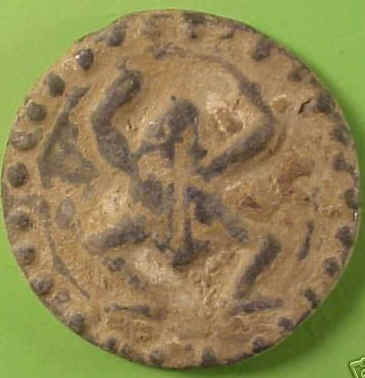 |
Burma lead coin Kingdom of Pyu with frog 500-800 AD Burmese (Myanmar)
Lead coin issued by the Kingdom of Pyu about 500-800 AD. With Frog. Most Pyu coins have
the sacred Hintha bird but I was able to buy two with a frog. I have seen less than six
with frogs in seventeen visits over twenty years. Crude. Reverse blank. About 30 mm. 15.52
grams. Lead was used as money for many centuries in Burma, up until 1885. US $61.05 (euro 48,75), Feb-16-05, ebay, neilsowards |
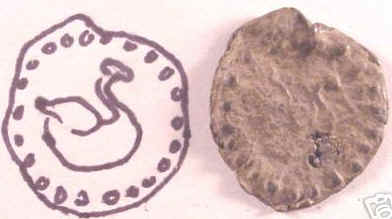 |
Burma lead coin Kingdom of Pyu with bird after 800 AD Burmese (Myanmar)
Lead coin issued by the Kingdom of Pyu after 800 AD. With Hintha or sacred bird right.
Reverse blank. About 18 mm. 2.3 grams. Lead was used as money for many centuries in Burma,
up until 1885. This coin is much thinner and lighter than most of the lead coins I have
seen in Burma and I think much scarcer. Being lighter I think they were made later--after
800 A.D. while the heavy ones were made 500-800 AD. US $9.99 (euro 7,98) geen biedingen, Feb-16-05, ebay, neilsowards |
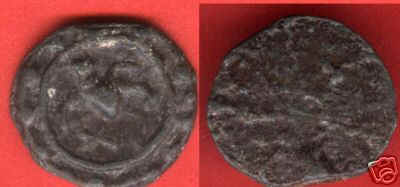 |
Burma, Pyu era lead coin, insect design, 800 ad EF These coins were
used in the area of Burma and North Thailand when the Post-Funan era left a power vaccuum
that spurred several power areas in the SE Asian area. This lead money is 2.3 cm wide, 1-2
mm thick and weighs 8 grams, consistent with the coins of the era. However, this design is
not one in my book. It is not a copy as it has marks that show wear over a long period of
time, and I got it at a place years ago when copy coins were not heard of. US $15,99 (EUR 12,38) 28-mrt-05, ebay, trader55553 |
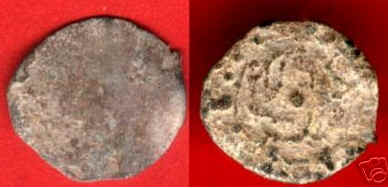 |
This is the kind of lead coin that was used in the area now called Burma, then known as Pyu. The coin has the typical uniface coin with a dotted outside rim and a bird in the center. This coin 1s 15 mm actross and about 1-2 grams of lead. US $11,99 (EUR 9,99), 25-jul-05, ebay, trader55553 |
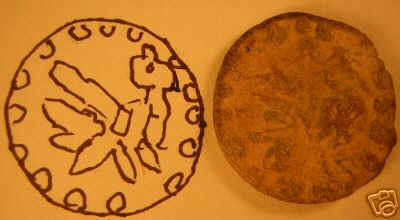 |
Burmese (Myanmar) Lead coin issued by the Kingdom of Pyu about 500-800 AD. With Hintha or sacred bird. Crude. Reverse blank. About 29 mm. 12.3 grams. Lead was used as money for many centuries in Burma, up until 1885. US $9,99 ( EUR 8,32) niet verkocht, 16-jul-05, ebay, neilsowards |
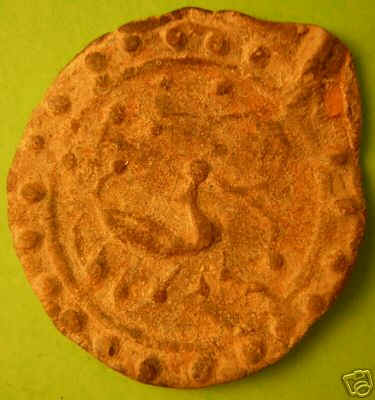 |
Burmese (Myanmar) Lead coin issued by the Kingdom of Pyu after 800 AD.
With Hintha or sacred bird right. Reverse blank. Coin has many dots around the bird
connected with lines--could this be a representation of a Burmese heavenly zodiac or
constellation? About 21 mm. 2.45 grams. Lead was used as money for many centuries in
Burma, up until 1885. This coin is much thinner and lighter than most of the lead coins I
have seen in Burma and I think much scarcer. Being lighter I think they were made
later--after 800 A.D. while the heavy ones were made 500-800 AD. US $9,99 ( EUR 8,32)
niet verkocht, 16-jul-05, ebay, neilsowards |
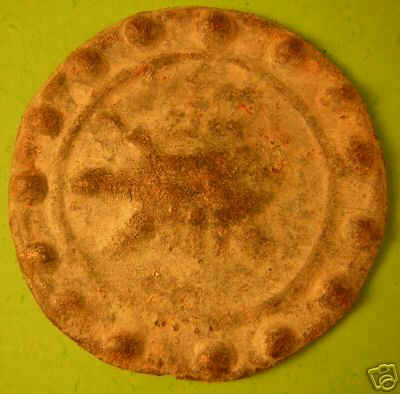 |
Burmese (Myanmar) Lead coin issued by the Kingdom of Pyu 500 to 800 AD.
With turtle. Reverse blank. About 27 mm. 10.6 grams. Lead was used as money for many
centuries in Burma, up until 1885. Most of these lead coins I have seen in seventeen
visits to Burma have a bird on them. I have seen less than five with a turtle so I think
they are quite scarce. They are not even listed in The Lead and Tin Coins of Pegu and
Tenasserim by M. Robinson. US $20.50 (EUR 16,62) 3-jul-05, ebay, neilsowards |
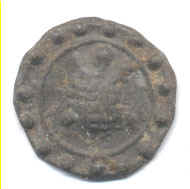 |
Ancient uniface Lead alloy coin featuring Turtle design from Burma. This
coin was mentioned to be from Pegu in the old days or present day Bago in Myanmar. US
$26.00 (euro 21) Jun-25-05, ebay, godzila8 |
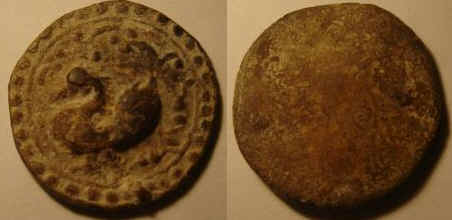 |
Pegu Lead Hintha Coin (south Burma) 16/17thC A Pegu lead coin from
southern Burma. These coins were first issued around AD1560 possibly under the reign of
King Bayinnaung and were in use until the early 1700s. fine detail of a hintha bird,
perhaps with foliage in a circle of dots. The hintha bird was an emblem used in the
ancient Mon kingdom in south Burma and is also found on many Burmese opium weights. It has
been suggested that the hintha bird is actually a Brahmani duck. There appears to be
confusion on e-bay about these coins. They are not Pyu coins. Pyu coins were silver coins
dating from some 800years before these lead coins were produced. Diameter : 2.6cm / 1inch Weight: approx. 9g GBP 62,00 ( EUR 90,88) 23-aug-05, ebay, shwenaga |
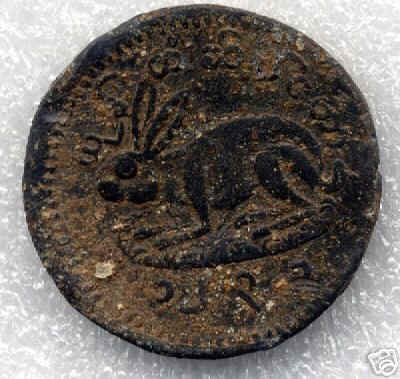 |
Burma 1/16 Lead Coin under King Mindon 1869-70 OBV: Hare (Rabbit) Facing Left with inscription and Date The Burmese People belived that there was a Hare (Rabbit) living on the Moon as such the Hare apears on the OBV of the 1/16 Pe, the same is also said for the Peacock as it was said to be in the Sun, it would be a Rosted Peacock for sure. REV: Value within wreath Details still clear, and Rare this Nice R&S 11.15 GBP 10,50 (EUR 15,39) 18-aug-05, ebay, 16jwoc |
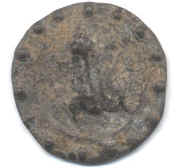 |
Burma Mon Kingdom Frog Lead Coin. Ancient Burma lead coin with frog
design; I got it from a dealer along the Thai-Burma border who said it was excavated from
the area of ancient Mon kingdom in present day Myanmar. US $53,55 (EUR 43,50) 10-aug-05, ebay, godzila8 |
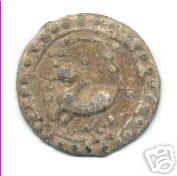 |
Ancient Tin alloy uniface coin featuring bird facing left with some blossoms. The coin was excavated from the area where ancient Mon kingdom used to prosper in present day Burma.US $15,00 (EUR 12,40), 04-sep-05, ebay, godzila8 |
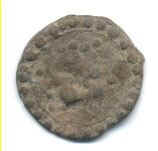 |
Ancient Tin alloy uniface coin featuring bird facing right with some blossoms. The coin was excavated from the area where ancient Mon kingdom used to prosper in present day Burma.US $12,00 (EUR 9,92), 04-sep-05, ebay, godzila8 |
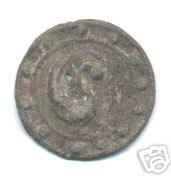 |
Ancient Tin alloy uniface coin featuring bird design. The coin was excavated from the area where ancient Mon kingdom used to prosper in present day Burma.US $9,99 (EUR 8,26), 04-sep-05, ebay, godzila8 |
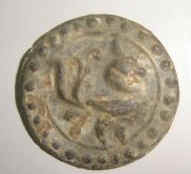 |
A Pegu lead coin from southern Burma. These coins were first issued around AD1560 possibly under the reign of King Bayinnaung and were in use until the early 1700s. The bird on this coin bears elaborate tail feathers and a crest on its head within a circle of dots. The hintha bird was an emblem used in the ancient Mon kingdom in south Burma and is also found on many Burmese opium weights. It has been suggested that the hintha bird is actually a Brahmani duck or Mandarin duck.Diameter: 30mmGBP 12,50 (EUR 18,49), 02-nov-05, ebay, shwenaga |
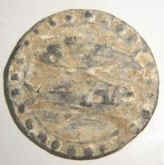 |
A Lead Coin from Pegu, Ancient Burma featuring two fish, one above the other, facing in opposite directions in a circle of dots. The reverse is blank. These fish are part of a rare series that included various animals, such as frogs, cows and turtles. The gills of the fish are clearly seen as is the eye and the opened mouth. This piece dates from approximately the mid 16th century to the early 18th century.Diameter: 30mmGBP 16,00 (EUR 23,67), 02-nov-05, ebay, shwenaga |
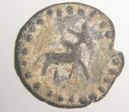 |
A Lead Coin from Pegu, Ancient Burma featuring a calf in a circle of dots on the obverse while the reverse is blank. This calf is part of a hard-to-find series that included various animals, such as frogs, turtles and fish. Coins with the hintha bird are far more commonly found. It dates from approximately the mid 16th century to the early 18th century.Diameter: 22mmGBP 9,05 (EUR 13,33), 16-okt-05, ebay, shwenaga |
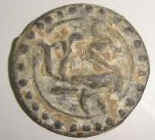 |
A Pegu lead coin from southern Burma. These coins were first issued around AD1560 possibly under the reign of King Bayinnaung and were in use until the early 1700s. This bird on this coin bears elaborate tail feathers and a crest on its head. The bird is in a circle of dots. The hintha bird was an emblem used in the ancient Mon kingdom in south Burma and is also found on many Burmese opium weights. It has been suggested that the hintha bird is actually a Brahmani duck. Diameter: 30mmGBP 5,99 (EUR 8,82), 16-okt-05, ebay, shwenaga |
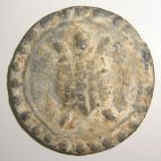 |
A Lead Coin from Pegu, Ancient Burma featuring a turtle in a circle of dots on the obverse while the reverse is blank. This turtle is part of a hard-to-find series that included various animals, such as frogs, cows and fish. The pattern of the turtle's shell can be seen with his head and all four limbs protruding. Coins with the hintha bird are far more commonly found. It dates from approximately the mid 16th century to the early 18th century. Diameter: 28mmGBP 42,10 (EUR 62,02), 20-okt-05, ebay, shwenaga |
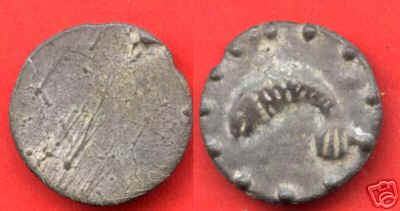 |
This is a Pyu era, ca 800 AD , lead coin, made with impure lead and uniface. It 2.7 cm ( 1 inch ) across . It weighs 12 -13 grams and is in EF condition. This one has a fish, not usual in this set of coins. got this in my work travels to Burma/Thai border in the 80's. I do not think it is a fantasy coin as it was not bought in the ' "era of Fakes" as it sees lately has become. It is not in any of the books that I have though the books refer to other kinds of motifs. US $16,99 (EUR 13,34), niet verkocht, 3 april 2006, trader55553 |
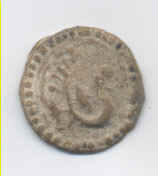 |
Tin uniface coin with swan motif from ancient Burma Mon kingdom.US $9,99 (EUR 7,85), 19-apr-06, ebay, godzila8 |
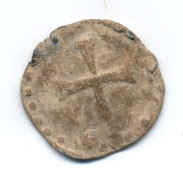 |
This is a rare type tin uniface coin with cross motif from ancient Burma Mon kingdom. Only a few pieces of this type found in hoard of thousands.US $31,05 (EUR 24,39), 19-apr-06, ebay, godzila8 |
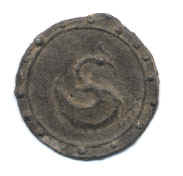 |
Uniface tin coin with swan motif from ancient Burma Mon kingdom.US $8,00 (EUR 6,28), 20-apr-06, ebay, godzila8 |
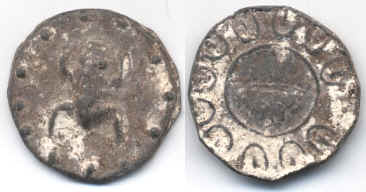 |
Ancient Burmese coin with Frog design on obverse.US $44,00 (EUR 34,56), 20-apr-06, ebay, godzila8 |
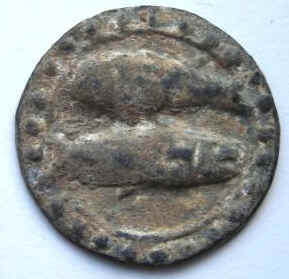 |
This a lead coin from the southern Burmese city of Bago, formally known as
'Pegu'. The obverse shows two fish lying horizontally one above the other. One faces left
and one right. You can clearly see the fins, eyes, gills and mouth. Both fish lie within a
circle of dots. The reverse is plain. Pegu lead coins are normally found with hintha birds on the obverse. This 'double fish' coin comes from a series of coins that are far rarer than the bird coins, featuring animals, including cows, frogs, shrimps, crocodiles and turtles. Diameter: 30mmGBP 7,00 (EUR 10,22), niet verkocht, 11-mei-06, ebay, shwenaga |
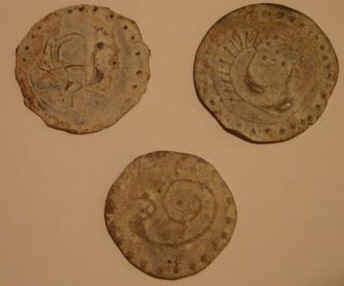 |
three lead coins, recently excavated from Mawlamyine in the south of Burma
(Myanmar). They are similar to the lead coins from Pegu although they are much thinner and
lighter. They feature stylised peacocks within a circle of dots, rather than the hintha
birds found on the Pegu coins. The reverses are blank. They date from approximately the
16th-17th century. These coins are much rarer than the Pegu hintha coins (often incorrectly labelled as 'Pyu coins' on ebay) and possess a delicate beauty. I am selling them together as i feel it would be a shame to separate them. Diameters: 26mm, 25mm and 23mmGBP 11,00 (EUR 16,06), 04-mei-06, ebay, shwenaga |
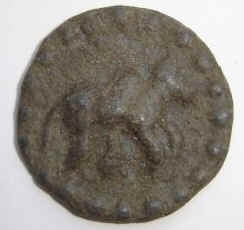 |
This a lead coin from the southern Burmese city of Bago, formally known as
'Pegu'. The obverse shows a humped bull facing right. The bull lies within a circle and a
ring of dots. The reverse is plain. This coin is slightly larger than most of the animal
coins in the series, with a diameter of 31mm rather than 27mm. Pegu lead coins are normally found with hintha birds on the obverse. This 'bull' coin comes from a series of coins that are far rarer than the bird coins, featuring animals, including cows, frogs, crocodiles and turtles. I've seen this series in three sizes, this coin being of the middle size.GBP 9,00 (EUR 13,04), 15-mei-06, ebay, shwenaga |
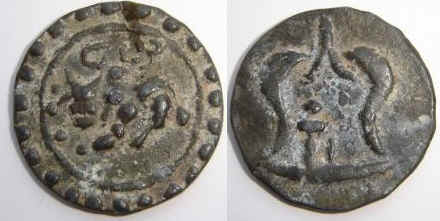 |
This is certainly an unusual piece. It comes from the Rakhine(Arakan)
state in the west of Burma (Myanmar). I can't date it as i haven't seen it before and have
been unable to find it documented - such is the nature of Burmese numismatics, there are
many coins that are unrecorded. It really is a beautiful piece. The design on the coin remains consistent with the Chandras dynasty in that the obverse shows a humped bull with garland (facing left) and an inscription above the bull - probably the name of the king at the time. There is a circle and a ring of dots around this image. The reverse shows a Srivatsa (Temple of Sri - the fertility goddess) often found on Rakhine and Pyu coins. Within the Srivatsa is a linga. Diameter: 32mmGBP 19,50 (EUR 28,25), 15-mei-06, ebay, shwenaga |
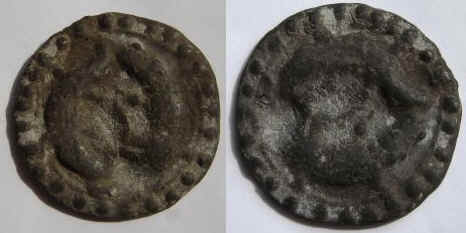 |
This is a very rare coin from the south of Burma from a series of coins
that feature various animals, including frogs, turtles, prawns and cows. Collectors will
be more familiar with the Pegu coins with hintha birds on the obverse, but coins from the
animal series are far rarer and extremely difficult to come by. The animal series coins come in at least two sizes, namely the smaller size of 28mm - 30mm and the larger size of 38mm - 40mm. This is one of the large coins and shows two crocodiles forming a circle with one's head facing the other's tail. The crocodiles are within a circle of dots. The reverse is blank. Diameter : 39mmGBP 7,50 (EUR 10,86), 08-mei-06, ebay, shwenaga |
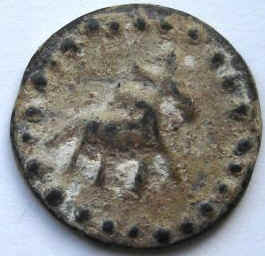 |
This a lead coin from the southern Burmese city of Bago, formally known as 'Pegu'. The calf is facing right and lies within a circle of dots on the obverse, while the reverse is plain. Pegu lead coins are normally found with hintha birds on the obverse. This calf coin comes from a series of coins that are far rarer than the bird coins, featuring animals, including cows, frogs, turtles, shrimps, crocodiles and fish. This coin is smaller than the other types in the animal series, only 23mm rather than 30mm.GBP 16,50 (EUR 23,90), 10-mei-06, ebay, shwenaga |
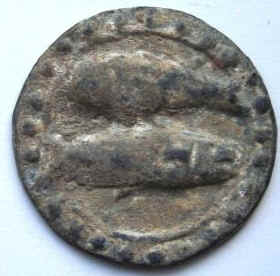 |
This a lead coin from the southern Burmese city of Bago, formally known as
'Pegu'. The obverse shows two fish lying horizontally one above the other. One faces left
and one right. You can clearly see the fins, eyes, gills and mouth. Both fish lie within a
circle of dots. The reverse is plain. Pegu lead coins are normally found with hintha birds on the obverse. This 'double fish' coin comes from a series of coins that are far rarer than the bird coins, featuring animals, including cows, frogs, shrimps, crocodiles and turtles. Diameter: 30mmGBP 21,00 (EUR 30,42) , 10-mei-06, ebay, shwenaga |
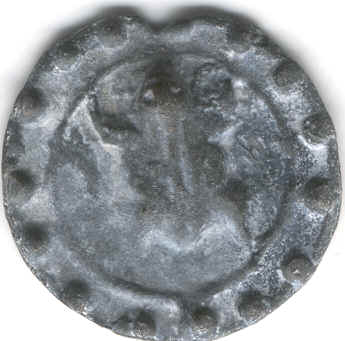 |
Burma lead coin Kingdom of Pygu with frog 1550-1590 vz: kikker kz: blanco 27,17 mm, 26,14, 4,33 mm dik 30 mm. 9,46 gram. |
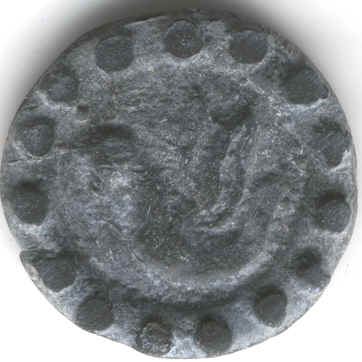 |
Burma lead coin Kingdom of Pygu with swan 1550-1590 vz: zwaan kz: leeg 28,05 mm, 28,51 mm, 2,99 mm dik, 14,60 gram |
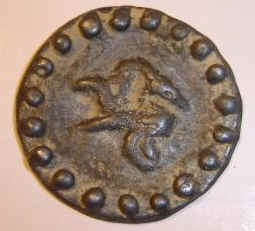 |
One of the largest lead coins from a series of coins featuring hintha
birds from the region near Bago in the south of Burma (Myanmar). The obverse shows a
hintha facing right with a long crest and upright tail. The bird is encircled by a ring of
dots. The reverse is blank. The coin dates to the 16th/17th century. Diameter: 44mm GBP 9,50 (EUR 14,18), 03-jan-07, ebay, shwenaga |
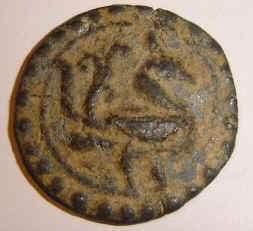 |
A lead coin from a series of coins featuring hintha birds from the
region near Bago in the south of Burma (Myanmar). The obverse shows a beautiful
representation of the hintha facing right with a long crest and an elaborate tail. The
bird is encircled by a ring of dots. The reverse is blank. The coin dates to the 16th/17th
century. Diameter: 29mm GBP 17,01 (Ongeveer EUR 25,39), 02-jan-07, ebay, shwenaga |
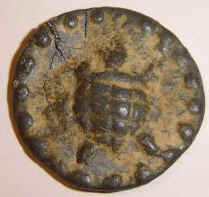 |
Lead coin from the region around Bago in the south of Burma. The
obverse shows a turtle with four flippers and head exposed with markings on its shell. The
turtle is encircled by a ring of dots. The reverse is blank. This coin is from a series of
lead coins featuring animals such as frogs, crabs, shrimps and fish. The coin dates from
the 16th to 17th centuries. This turtle coin is one of the rarest of the series along with
the crocodile and the shrimp. Diameter: 23mm GBP 77,00 (EUR 114,95), 02-jan-07, ebay, shwenaga |
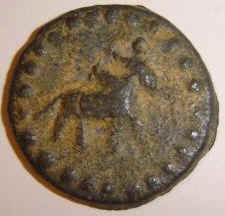 |
Lead coin from the region around Bago in the south of Burma. The
obverse shows a small calf facing to the right. The calf is encircled by a ring of dots.
The reverse is blank. This coin is from a series of lead coins featuring animals such as
frogs, crabs, shrimps, fish and turtles. The coin dates from the 16th to 17th centuries. Diameter: 23mm GBP 10,50 (EUR 15,68), 03-jan-07, ebay, shwenaga |
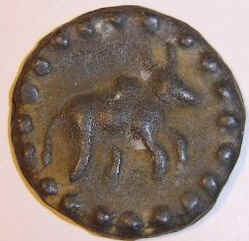 |
Lead coin from the region around Bago in the south of Burma. The
obverse shows a horned bull with a hump facing right. The bull is surrounded by a circle
of dots. The reverse is blank. This coin is from a series of lead coins featuring animals
such as frogs, crabs, shrimps, fish and turtles. The coin dates from the 16th to 17th
centuries. Diameter:30mm GBP 12,51 (EUR 18,68), 03-jan-07, ebay, shwenaga |
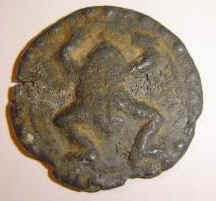 |
Lead coin from near Bago in the south of Myanmar (Burma). This coin
comes from a series of animal coins that includes turtles, crabs, shrimps, cows, fish and
crocodiles. The coin dates to the 16th-17th century. The obverse features a frog with
splayed limbs in a circle and a ring of dots. The reverse is blank. Diameter: 29mm GBP 21,00 (EUR 31,35), 30-dec-07, ebay, shwenaga |
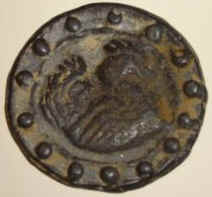 |
A very rare coin from the southern part of Burma (Myanmar) near the
city of Bago. This coin features a plump hantha or chicken with a crest in a circle of
dots. The reverse is blank. It comes from a series of coins stamped with birds, although
this particular design is scarce and comes from a horde of coins unearthed earlier this
year. Diameter: 44mm GBP 32,50 (EUR 48,52), 29-dec-07, ebay, shwenaga |
Coins of Burma
Zilver Burma
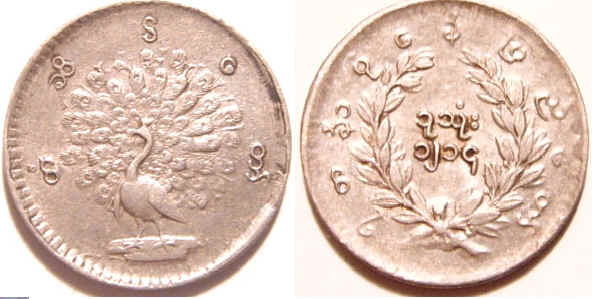 |
BURMA - 1852 MU GBP 8,50 (EUR 12,42), 04-apr-05, ebay, collectors-online |
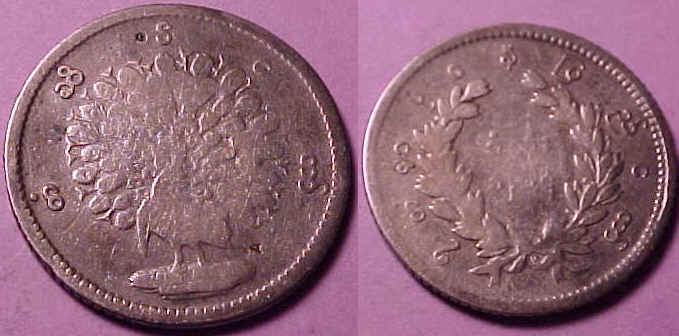 |
BURMA 1/4 RUPEE SILVER 1852 PEACOCKUS $3.00, Nov-06-05, ebay, flacoin |
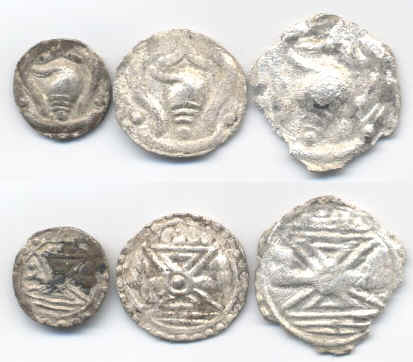 |
AD 600-637 Set of 3 silver coins to complete the whole series. The full unit coin is chipped but the half unit has good detail and so is the quarter unit piece. The coins have damaru emblem on one side and shell in temple design on the other side. A scarcer type of the Srikshetra kingdon of Pyu people in central Burma. US $150,00 ( EUR 124,93), niet verkocht, 14-jun-05, ebay, godzila8 |
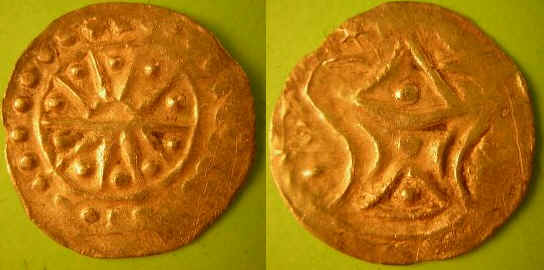 |
Burmese silver coin from the Kingdom of Funan 190-550 AD. One Quarter unit. 2.24 grams. About 22 mm. Rising sun on one side, Temple on the other. US $12,00 ( EUR 9,99), 16-jul-05, ebay, neilsowards |
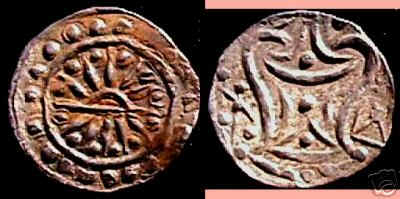 |
Good silver 1/4 unit struck 400-550 AD Kingdom of Funan which is now in Myanmar (Burma). 20mm diameter of 4/5 of an inch wide. Similar to Mitchiner 1978 numbers 253-256. Obverse is rising sun / reverse is a temple with sun and moon above. US $24,99 (EUR 20,30) geen biedingen, 25-aug-05, ebay, barnowlc |
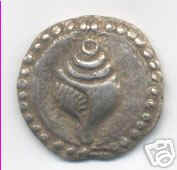 |
Mitchiner 516-8, 5-6th Cnetury silver coinage from Pegu (Hamsavati) kingdom of Mon people. This piece is of the type with very fine style of the shell with 2 small reticles and temple design on reverse side US $135.00 (euro 111), Jun-14-05, ebay, godzila8 |
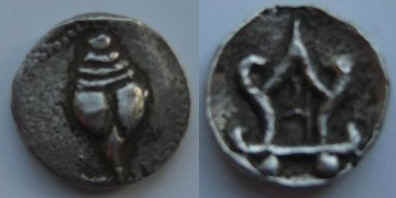 |
An ancient Mon silver coin with a conch shell in a circle of dots (only
partially visible now - see photo) on the obverse and a Srivatsa (Temple of Sri, fertility
goddess) on the reverse. The conch or shell was a good luck symbol often associated with
the Hindu god Vishnu. The conch is also found on some Pyu and Chandra coins. The Mons were
from southern Burma and founded the kingdom of Dvaravati. Mon coins are typically thicker
than the Pyu, this particular specimen is between 2 and 3mm thick. It dates from
approximately AD400 - AD500. Diameter : 20mm Thickness : 2-3mm Weight : approx. 7gGBP 67,50 ( EUR 99,85) , Sep-10-05, ebay, shwenaga |
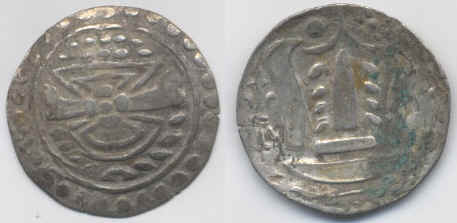 |
AD 800-835 full unit silver coinage from Pyu kingdom of Srikshetra in very nice condition. This type of coin has curved flan with very high technology manufacturing you will be amazed how people in more than a thousand years ago manage to make some coin like this. The coin features Damaru emblem on one side while the other side has stupa or lingam inside the temple with 8 dots surrounding. US $99.00 (euro 81) niet verkocht, Jun-14-05, ebay, godzila8 |
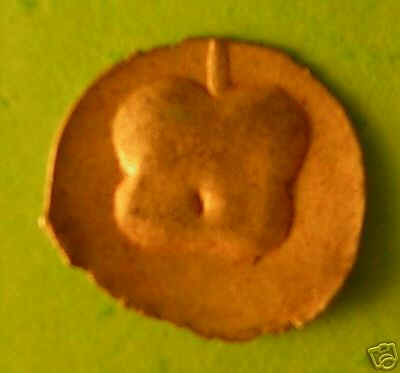 |
Tiny unknown, unlisted Burmese (Myanmar) silver coin. Less than .1 gram! Burmese coin collector said, he had purchased a small silver container full of over 500 of these tiny silver coins. If lost individually, they would oxidize and crumb to nothing which is probably why they are unknown. This coin is only 6 mm is diameter and so thin the design shows through incused on the reverse like a medieval bracteate. The design has no parallel in known Burmese coins being four lobs with a stem on top (or bottom like a four leaf clover). Unlisted in any Burmese coin catalog that I know about. There are 1/100 units listed in Robinson and Shaw under the Pyu Kingdom 500 AD to 800 AD. These Pyu 1/100 units range from .14 to .09 grams. Color is toned silver. US $6.50 ( EUR 5,20), 4 aug 2005, ebay, neilsowards |
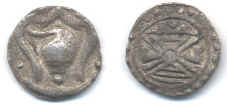 |
Burma 600 AD Srikshetra Damaru/Shell in Temple Silver Quarter Unit silver coin from Srikshetra kingdom located in Burma 600-637 AD. The coin weighs 2.5 grams US $37,80 ( EUR 30,66), 3 aug 2005, ebay, godzila8 |
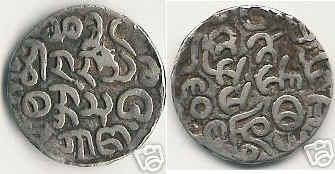 |
Burma, Arakan tanka, Sanda Thudhamma, 1652-74 US $75,00 (EUR 60,92) 24-aug-05, ebay, fortes27 |
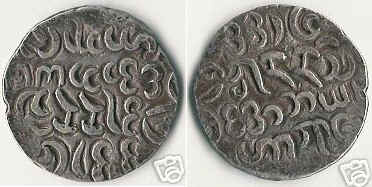 |
Burma, Arakan, Tanka of Apaya Maya Raja, 1764-73 AD US $86,50 (EUR 70,26) 24-aug-05, ebay, fortes27 |
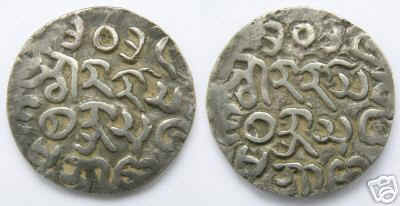 |
Arakan Burma India coinGBP 29,99 (EUR 44,26), 29-sep-05, ebay,
coinsncollectibles |
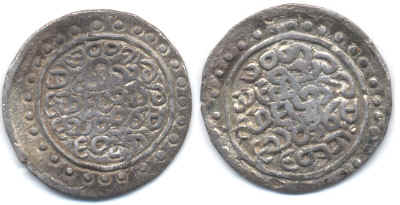 |
Burma Arakan kingdom silver Rupee issued during the reign of king Thado dated 1007 in Arakanes year (1645 AD). The coin weighs 9.3 grams and has Arakanese inscription which reads "Lord of the Red Elephant, Lord of the White Elephant. Thado king of Righteousness.US $56,00 (EUR 46,28), 03-okt-05, ebay, godzila8 |
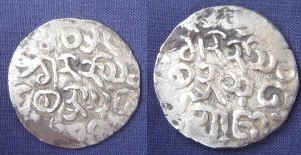 |
A coin from the Mrauk-U dynasty in Arakan (Rakhine) State in Burma. This
coin bears the inscription: 1014 Sanda Thudhamma Raza, The Lord of the Golden Palace. The
obverse and reverse bear the same inscription. 1014 refers to the start of the King, Sanda Thudhamma Raza's reign. This is BE or Buddhist Era and corresponds to the year AD1652. Interestingly, this coin was the first to refer to the king as 'Lord of the Golden Palace' as previously the kings were given the title 'Lord of the White Elephant' or 'Lord of the Red Elephant'. Sanda Thudhamma Raza ruled for 22 years AD1652-1674 and came to the throne at the age of 25, succeeding his father, Thado Min Taya. During his reign he built many pagodas and established trade links with the Dutch. After his reign, the kings enjoyed less power as the Mrauk-U dynasty began to fall into decline. His reign is considered to mark the end of the 'Golden Period' of the Mrauk-U dynasty making this coin of particular interest. Diameter : 30mmGBP 8,99 (EUR 13,22), 26-okt-05, ebay, shwenaga |
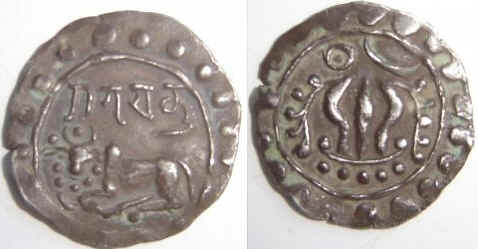 |
Chandra dynasty coin in excellent condition dating from betweeen AD 450
and AD 560. - The obverse depicts a humped bull with a garland around his neck. Above is a Brahmi inscription of the king's name. I have identified the final two letters as 'chan-dra' - i'm still trying to find out what the first two mean. The bull and king's name are encircled in a ring of dots. - The reverse bears a symbol that has been described by some as a stylised trident, but equally it may represent a Srivatsa (Temple of Sri, fertility goddess) found on many Mon and Pyu coins that share the Hindu influences. Above, there is a sun on the left and a moon on the left. Again, all are within a circle of dots. Diameter: 23mm Weight : approx. 4gGBP 64,00 (EUR 94,45), 13-sep-05, ebay, shwenaga |
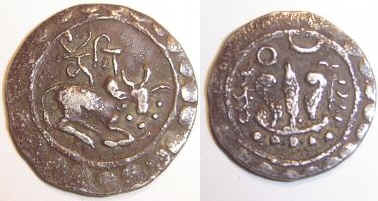 |
Chandra dynasty coin in excellent condition dating from betweeen AD 450
and AD 560. - The obverse depicts a humped bull with a garland around his neck. In this coin the bull's head faces right whereas in most coins in this series it faces left. Above is a Brahmi inscription of the king's name. The bull and king's name are encircled in a ring of dots. - The reverse bears a symbol that has been described by some as a stylised trident, but equally it may represent a Srivatsa (Temple of Sri, fertility goddess) found on many Mon and Pyu coins that share the Hindu influences. Above, there is a sun on the left and a crescent moon on the left. Again, all are within a circle of dots. Diameter : 21mm Weight: approx. 4gGBP 52,00 (EUR 76,74), 22-sep-05, ebay, shwenaga |
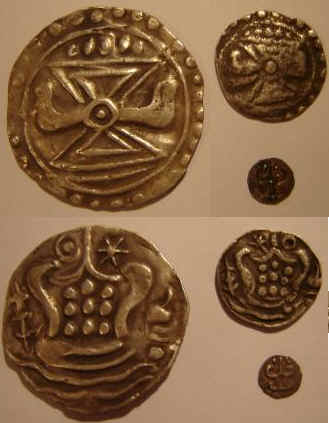 |
Set of the Bhadrapitha/Srivatsa series of Ancient Pyu Silver coins,
probably originating from the Pyu city, Sriksetra. Includes 'Full unit', One quarter unit'
and 'One hundredth unit'. AD300- AD700. Obverse shows the Bhadrapitha Symbol while
the reverse depicts the Srivatsa symbol (the Temple of Sri, fertility goddess) with sun
and moon above, conch shell on the right and thunderbolt to the left. Full unit coin is 32mm in diameter and weighs approx. 10g One Quarter unit is 18mm in diameter and weighs approx. 2.5g One Hundredth unit is 8mm and weighs less than 1g GBP 67,00 (EUR 98,21) 16-aug-05, ebay, shwenaga |
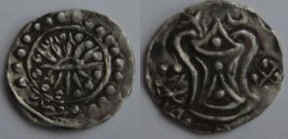 |
Silver Pyu Rising Sun Series Coin - Burma AD500 (19mm)An Ancient Pyu
coin featuring the Rising Sun (five rays above and five below) in a circle of dots on the
obverse. The reverse shows a stylised Srivatsa (Temple of Sri, fertility goddess) with sun
and moon above, a swastika on the right and a Bhadrapitha emblem on the left. These coins
are normally associated with the Pyu city of Halin. Diameter - 19mm Weight - approx 2g GBP 10,50 (EUR 15,50), 31-aug-05, ebay, shwenaga |
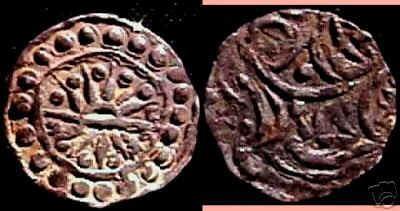 |
Sun Temple 400-550 AD BURMA Funan SILVER 20mm MyanmarGood silver 1/4
unit struck 400-550 AD Kingdom of Funan which is now in Myanmar (Burma). 20mm diameter of
4/5 of an inch wide. Similar to Mitchiner 1978 numbers 253-256. Obverse is rising sun /
reverse is a temple with sun and moon above. US $24,99 (EUR 20,65), geen biedingen, 01-sep-05, ebay, barnowlc |
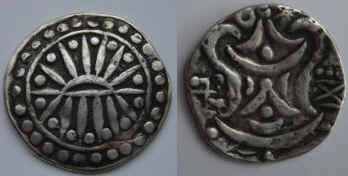 |
Silver Pyu Rising Sun Series Coin - Burma AD500 (29mm)Ancient Pyu coin
featuring the Rising Sun (six rays above and six below)in a circle of dots on the obverse.
The reverse shows a stylised Srivatsa (Temple of Sri, fertility goddess) with sun and moon
above, a swastika on the left and a Bhadrapitha emblem on the right. These coins are
normally associated with the Pyu city of Halin. Diameter - 29mm Weight - approx. 6g GBP 56,00 (EUR 82,64), 01-sep-05, ebay, shwenaga |
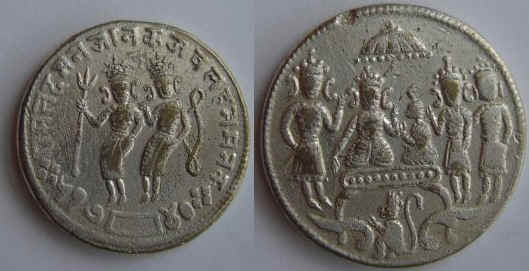 |
HIndu Temple Token - India / Arakan - BurmaThis coin was found in
Arakan state in Burma and has been described by U San Tha Aung in 'Arakanese Coins' as a
Hindu Temple token. It may originally come from India. It's an unusual piece with an
inscription on the obverse and two figures, one holding a trident, the other a bow . Both
are wearing headdresses. The reverse depicts three figures attending two further figures
on a royal couch/throne with an umbrella overhead. I'm assuming the umbella is covering an
important figure, perhaps royalty. A monkey at the base of the coin is looking up at the
royal figure. 28mm diameter and 2mm in thickness Weight - 13g GBP 9,50 (EUR 14,02), 01-sep-05, ebay, shwenaga |
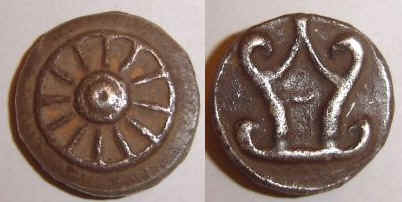 |
Mon Wheel-Srivatsa Coin from Burma, approx. AD400 - 500. Typical of Mon
coins, this piece is thick (2mm) with prominent designs. The obverse shows a wheel with a
centre rim and 12 spokes known as the dharmachakra ( a symbol of 'turning the wheel of
Buddhist law). The reverse depicts a srivatsa (Temple of Sri, fertility goddess) with a
small crescent moon in the middle, possibly a symbol of royalty. Diameter : 20mm Weight : 9gGBP 185,00 (EUR 272,11), 18-sep-05, ebay, shwenaga |
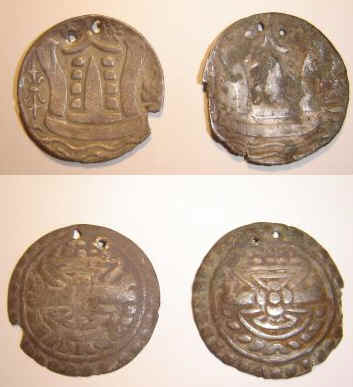 |
A pair of the Bhadrapitha/Srivatsa series of Ancient Pyu Silver coins.
There are three known types of Pyu coins in the Bhadrapitha/Srivatsa series. These two
come from what is referred to as the Class D series. Previously on ebay I sold a set of
three coins from the Class C. While the obverse of these coins is much the same as the
other types, the reverse differs. These coins are generally associated with the Pyu cities
of Sriketsra and Beikthano. They were produced later than other Pyu coins, probably around
the 9th century when the Pyu kingdom was in decline. Please note that i'm selling these
two coins together. As you'll see from the photos, the reverse of one needs some cleaning,
but has a well-defined obverse. The other coin has a truly excellent reverse but a not so
clear obverse. That's why i'm putting them in the same lot. Obverse - Bhadrapitha symbol. Note that the centre of the symbol takes the form of a four-petaled rosette, whereas in the Class C and D series the centre is a solid circular disc. Reverse - Simple form of a srivatsa (Temple of the fertility goddess, Sri) with an obelisk or phallus in the centre, flanked by eight small angular bead-like objects. On the left is a vajra (thunderbolt) and a wavy conch to the right. Above the srivatsa is a sun with rays and a moon. The moon is no longer visible due to holes made at the top, at a later date, that suggests the coins have been as part of a necklace. Below the srivatsa are two wavy lines, representations of water. Weight : 7g eachGBP 10,00 (EUR 14,71), 21-sep-05 , ebay, shwenaga |
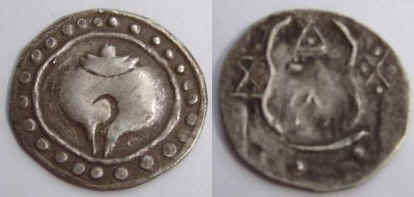 |
silver Mon coin from the Dvaravati period circa AD 600-700. The coin bears
similar symbols to those found on the Pyu coins, but is much thinner and lightweight. Obverse: A wide Sankh (conch) shell within a circle line and a circle of dots. The conch shell was a Hindu symbol used across Southeast Asia. Reverse: Stylised Srivatsa (Temple of Sri - fertility goddess) with bhaddapitha emblem on the left and a swastika on the right. Diameter: 17mmGBP 27,50 (EUR 40,20), 06-mei-06, ebay, shwenaga |
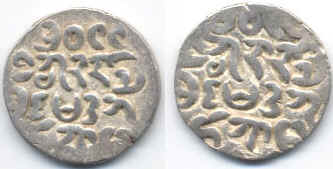 |
Arakan silver tanka Rupee dated 1099 BE (1737 AD) in excellent sharp detail which is scarce for these Arakan coins. Inscribed as Lord of the Golden Palace - Madarit Raja.US $69,99 (EUR 54,91), 09-mei-06, ebay, godzila8 |
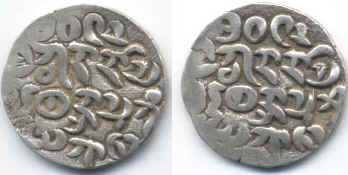 |
Arakan silver tanka Rupee dated 1093 BE (1731 AD) in excellent sharp detail which is scarce for these Arakan coins. Inscribed as Sanda Thuriya Raja.US $64,29 (EUR 50,44), 09-mei-06, ebay, godzila8 |
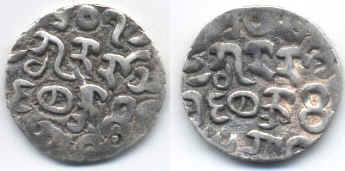 |
Arakan silver tanka Rupee dated 1072 BE (1710 AD) in excellent sharp detail which is scarce for these Arakan coins. Inscribed as Lord of the Golden Palace - Sanda Wizaya Raja.US $59,32 (EUR 46,54), 09-mei-06, ebay, godzila8 |
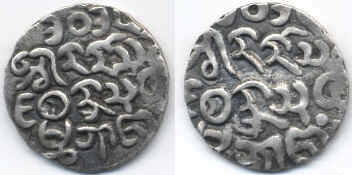 |
Arakan silver tanka Rupee dated 1014 BE (1652 AD) in excellent sharp detail which is scarce for these Arakan coins. Inscribed as Lord of the Golden Palace - Sanda Thudhamma Raja.US $49,99 (EUR 39,22) niet verkocht, 09-mei-06, ebay, godzila8 |
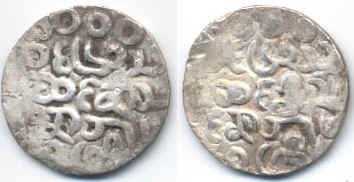 |
Arakan silver tanka Rupee dated 1000 BE (1638 AD). Inscribed as Lord of the White elephant, Lord of the Red elephant - Narabadigyi.Authenticity guaranteed.US $54,27 (EUR 42,57), 09-mei-06, ebay, godzila8 |
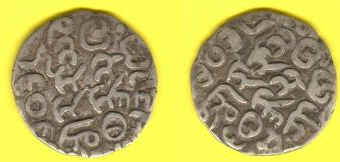 |
Ancient Arakan Burma coins This coin made by Silver and used about 1014-1046 BE = 1652 AD in Lord of the Golden Palace, Sanda Thudhamma Raja. The character Burma " 1014 Shwe Nan Thakhin Sanda Thudhamma Raja" and dimenter 2.8 cm. weight 10.19 gm,US $39,99 (EUR 31,37) niet verkocht, 29-apr-06, ebay, jackstamp2005 |
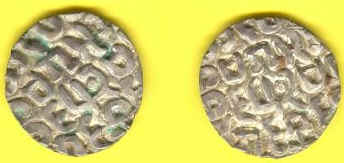 |
Ancient Arakan Burma coins This coin made by Silver and used about 1146 BE = 1784 AD in Amarapura, Kingdom of the Lord of Many White Elephants. The character Burma is " 1146 Khu Amarapura Hsin byu mya Shin naing ngan. This is variety with a dot on the character "byu" and dimenter 2.8 cm. weight 10.15 gm, US $44,99 (EUR 35,29) niet verkocht, 29-apr-06, ebay, jackstamp2005 |
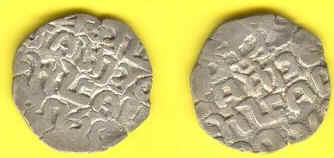 |
Ancient Arakan Burma coins This coin made by Silver and used about 1146 BE = 1784 AD in Amarapura, Kingdom of the Lord of Many White Elephants. The character Burma is " 1146 Khu Amarapura Hsin byu mya Shin naing ngan" and dimenter 2.7 cm. weight 10.06 gm, US $24,99 (EUR 19,60) niet verkocht, 9-mei-06, ebay, jackstamp2005 |
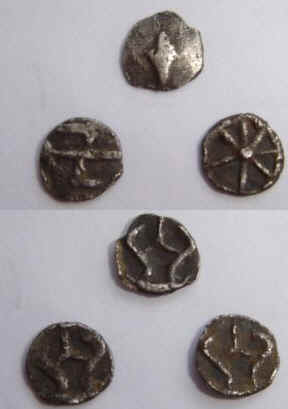 |
A set of three small Pyu coins from the ancient city of Sriketsra. What
makes these so unusual is that they appear to be part of a set and are very small indeed,
only 7mm. These coins are extremely rare, especially when all three are together. They are made of silver and feature three different designs on the obverses: the conch, the wheel and what i believe to be a swastika. The conch, swastika and the wheel were originally Hindu symbols that began to be used in Buddhism. The wheel symbolises the dharmachakra, the Buddhist Law. These coins show how important Hinduism, namely the cult of Vishnu, was for the Pyu people. The reverse of each coin displays Srivatsa symbols (Temple of Sri, the fertility goddess or mother goddess)GBP 32,00 (EUR 46,36), 13-mei-06, ebay, shwenaga |
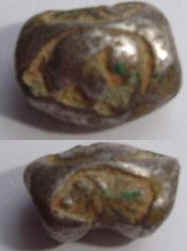 |
Here is a most unusual piece that appears to be a form of 'majizi' or bean
money. It is made of silver and was most probably used in the Shan states. An elephant is
stamped on the 'front' and a fish is stamped on the 'top'. You can see the shape of the
piece below. The face with the elephant is 11mm while the one with the fish is 7mm. I've only found two such pieces in the last ten years and so would make a wonderful addition to any collection.GBP 23,50 (EUR 34,04), 11-mei-06, ebay, shwenaga |
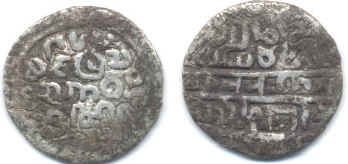 |
Very rare Arakan silver Rupee of King Naratibbati (1593-1612) with inscription of date in Arakanese year of 963 (1605). The legends are in 3 languages : Arakanese, Persian and Nagari : Lord of the White Elephant - Naratibbati Salim Shah. Authenticity guaranteed. No reserve. Scratches on coin but a very nice piece from over 4 centuries ago.US $69,99 (EUR 55,60) niet verkocht, 16-jun-06, ebay, godzila8 |
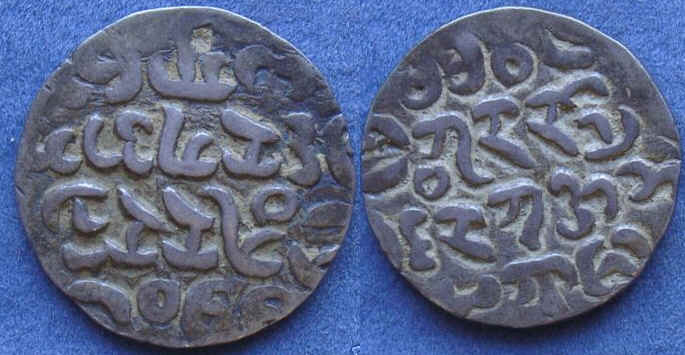 |
Arakan Burma Myanmar 1104 Nara Apaya 1742 KM 22GBP 27,99 (EUR 40,55), 07-jun-06, ebay, simmonsgallery |
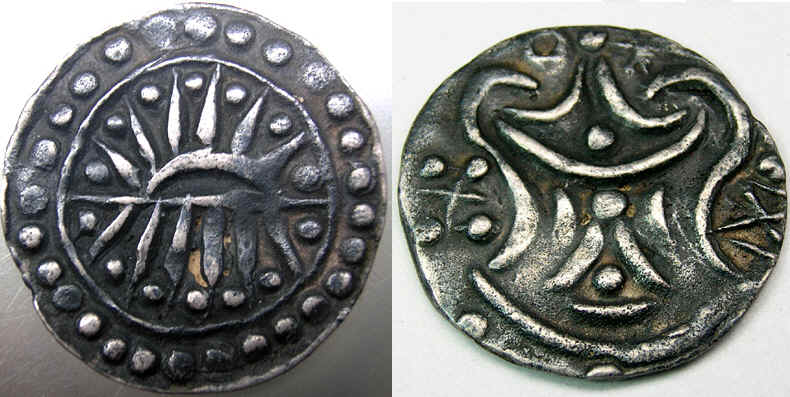 |
THAILAND/BURMA ANCIENT FUNAN SILVER COIN, SCARCEWeight : 7.3 gms. Diameter : 29 mm. Mintage : No Record Material : Silver DESCRIPTION : THE PEOPLES OF INDO - CHINA PRODUCED THE HAMMERED FLAT COINS FOR TRADE USE IN THIS AREA SINCE THE 1st CENTURY A.D., PRIOR TRADE DONE ONLY THROUGH BARTER TRADE. THE EMPIRE OF FUNAN WAS IN THE PERIOD OF 1st A.D. TO THE 6th A.D. CENTURY PRODUCED HAMMERED FLAT COINS FROM MANY MATERIALS SUCH AS LEAD, TIN, SILVER AND GOLD. THE OBVERSE SHOWN RISING SUN BUT THE REVERSE HAS MANY DESIGNED. THIS SILVER COIN THE REVERSE SHOWN SRI WAT SA WITH ON TOP RIGHT IS THE SUN, LEFT IS THE MOON. MIDDLE LEFT IS SWASTIKA (GOOD LUCK SYMBOL) US $39,99 (EUR 31,33), 17-jul-06, ebay, thaigemscoins |
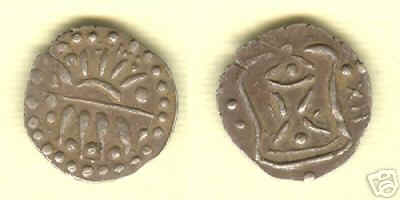 |
Old Ancient Cambodia, Thailand and Burma coins, Funan Kingdom in 6th to
11th Century You have biding on old ancient Funan Kingdom Silver coin, Its can found thoughout Southeast Asia in Cambodia, Thailand and Burma. its show Phra Athit Uthai (The Rising Sun) in a circle line and a ring of dots, the reverse show Sri Wat Sa (hair on the chest of Vishnu), in the centre, to right and left of Sri Wat Sa are representations of the hand-drum, which is used during religious service and a Swastika, symbol of good fortune. Above are the Moon and the sun. Funan Kingdom is between 6th to 11th Century. This coin come from Burma and made by Silver, diameter 17 mm, weight 1.6 gms.,US $14,99 (EUR 11,73), 18-jun-06, ebay, se-asiacollection |
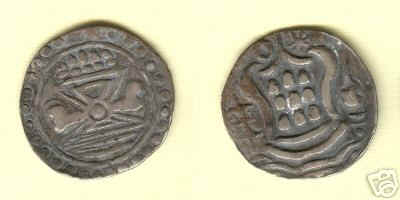 |
Old Ancient Burma coins, Pyus era in 5th to 9th Century You have biding on old ancient Pyus era Silver coin, Its can found in Burma and some place of Thailand. its show Bhadrapitha in a circle line and a ring of dots, the reverse show Sri Wat Sa (hair on the chest of Vishnu), in the centre, to right and left of Sri Wat Sa are a Sankh Shell and a Thunderbolt. Above are the Moon and the sun, under are two or more curved wavy lines probably denoting water. Pyus era is between 5th to 9th Century. This coin come from Burma and made by Silver, diameter 35 mm, weight 10.5 gms.,US $61,00 (EUR 47,74), 18-jun-06, ebay, se-asiacollection |
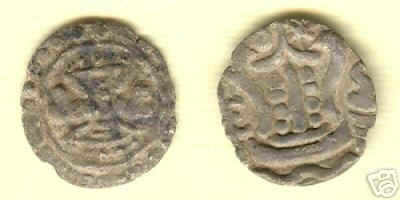 |
Old Ancient Burma coins, Pyus era in 5th to 9th Century You have biding on old ancient Pyus era Silver coin, Its can found in Burma and some place of Thailand. its show Bhadrapitha in a circle line and a ring of dots, the reverse show Sri Wat Sa (hair on the chest of Vishnu), in the centre, to right and left of Sri Wat Sa are a Sankh Shell and a Thunderbolt. Above are the Moon and the sun, under are two or more curved wavy lines probably denoting water. Pyus era is between 5th to 9th Century. This coin come from Burma and made by Silver, diameter 19 mm, weight 2.1 gms., US $20,50 (EUR 16,04), ebay, se-asiacollection |
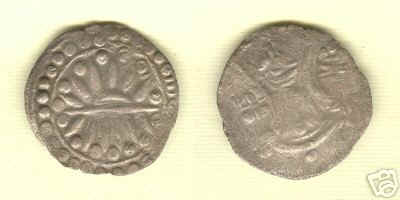 |
Old Ancient Cambodia, Thailand and Burma coins, Funan Kingdom in 6th to 11th Century.Its can found thoughout Southeast Asia in Cambodia, Thailand and Burma. its show Phra Athit Uthai (The Rising Sun) in a circle line and a ring of dots, the reverse show Sri Wat Sa (hair on the chest of Vishnu), in the centre, to right and left of Sri Wat Sa are representations of the hand-drum, which is used during religious service and a Swastika, symbol of good fortune. Above are the Moon and the sun. Funan Kingdom is between 6th to 11th Century. This coin come from Thailand and made by Silver, diameter 30 mm, weight 8.5 gms.US $24,99 (EUR 19,46), 07-aug-06, niet verkoch, ebay, se-asiacollection |
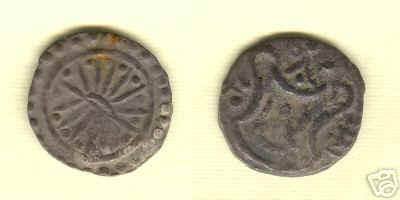 |
Old Ancient Cambodia, Thailand and Burma coins, Funan Kingdom in 6th to
11th Century. Its can found thoughout Southeast Asia in Cambodia, Thailand and Burma. its
show Phra Athit Uthai (The Rising Sun) in a circle line and a ring of dots, the reverse
show Sri Wat Sa (hair on the chest of Vishnu), in the centre, to right and left of Sri Wat
Sa are representations of the hand-drum, which is used during religious service and a
Swastika, symbol of good fortune. Above are the Moon and the sun. Funan Kingdom is between
6th to 11th Century. This coin come from Thailand and not cleaning and made by Silver,
diameter 28 mm, weight 8.8 gms.US $49,99 (EUR 38,94), 07-aug-06, niet verkoch, ebay,
se-asiacollection |
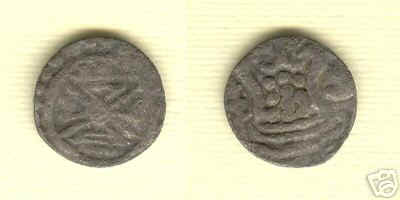 |
Old Ancient Burma coins, Pyus era in 5th to 9th Century. Its can found in Burma and some place of Thailand. its show Bhadrapitha in a circle line and a ring of dots, the reverse show Sri Wat Sa (hair on the chest of Vishnu), in the centre, to right and left of Sri Wat Sa are a Sankh Shell and a Thunderbolt. Above are the Moon and the sun, under are two or more curved wavy lines probably denoting water. Pyus era is between 5th to 9th Century. This coin come from Burma and made by Silver, diameter 17 mm, weight 2.3 gms.US $19,99 (EUR 15,57), 07-aug-06, niet verkoch, ebay, se-asiacollection |
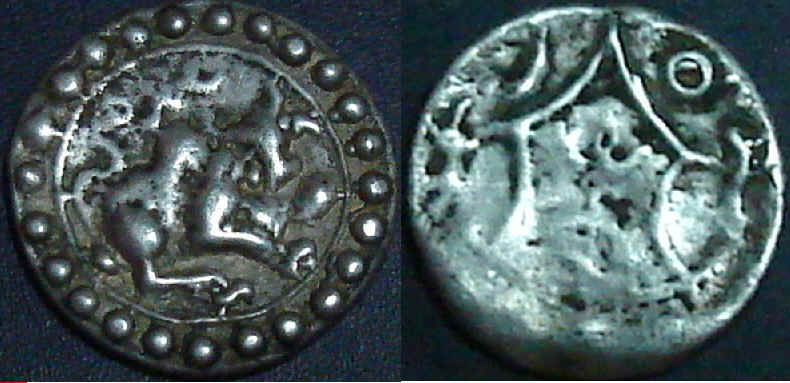 |
THAILAND/BURMA ANCIENT FUNAN SILVER COIN You have biding on old ancient Funan Kingdom Silver coin, Its can found thoughout Southeast Asia in Cambodia, Thailand and Burma. , Funan Kingdom is between 6th to 11th Century. This coin come from Thailand and made by Silver,US $29,99, EUR 23,36, niet verkocht, 06-aug-06, ebay, pee397a |
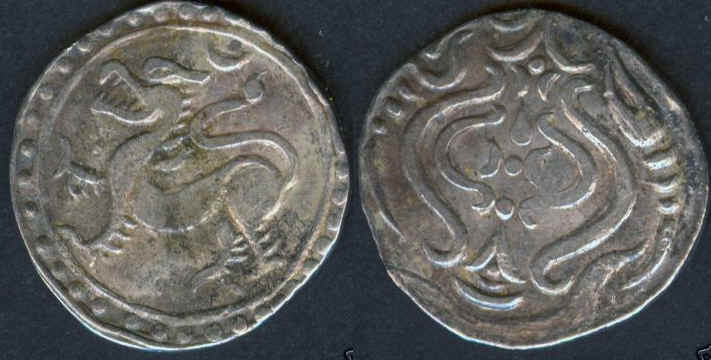 |
Old Ancient Cambodia, Thailand or Burma coins, Dvaravati Kingdom in 6 -
11th Century You have biding on old ancient Dvaravati Kingdom Silver coin. its show Lion in a circle line and ring of dots, the reverse show Sriwatsa Symbol with Sankh Shell both side. Dvaravati Kingdom is between 6th to 11th Century. This coin come from Thailand and made by Silver, diameter 26 mm, weight 7.4 gms.US $39,99 (EUR 31,19), 27-okt-06, ebay, se-asiacollection |
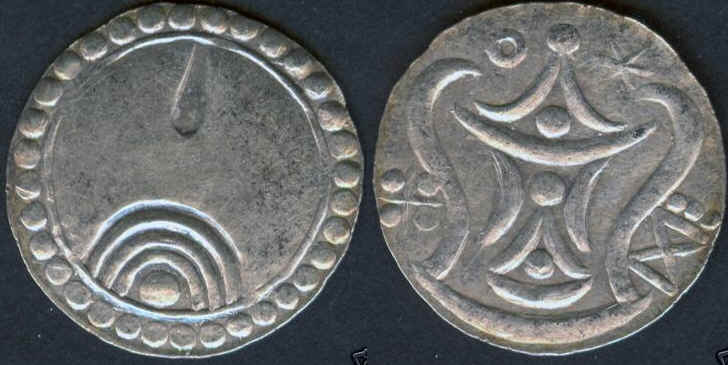 |
Old Ancient Cambodia, Thailand and Burma coins, Dvaravati Kingdom in 6th
to 11th Century You have biding on old ancient Dvaravati Kingdom Silver coin. Its show Sankh shell in a circle line and a ring of dots, the reverse show Sri Wat Sa (hair on the chest of Vishnu), in the centre, to right and left of Sri Wat Sa are representations of the hand-drum, which is used during religious service and a Swastika, symbol of good fortune. Above are the Moon and the sun. Dvaravati Kingdom is between 6th to 11th Century. This coin come from Thailand and made by Silver, diameter 2.6 mm, weight 4.6 gms.US $24,99 (EUR 19,49), 27-okt-06, ebay, se-asiacollection |
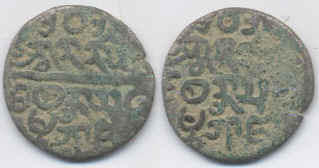 |
silver tanka half Rupee from ancient Arakan kingdom located in Western part of present day Burma / Myanmar. The coin is dated 1014 Burmese year which corresponds to 1652 AD from the reign of king Sanda Thudhamma. This coin id of scarce type with horizontal center line dividing to two halves. With lower silver composition it is believed that it is of value of half Rupee which the silver bullion content is correspond to around half of the normal silver Rupees.US $99,99 (EUR 77,46), 25-jan-07, ebay, godzila8 |
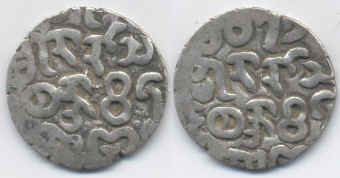 |
silver tanka Rupee from ancient Arakan kingdom located in Western part of present day Burma / Myanmar. The coin dated 1072 Burmese year which corresponds to 1710 AD from the reign of king Sanda Wizaya.US $55,00 (EUR 42,61), 25-jan-07, ebay, godzila8 |
Subscribe to:
Posts (Atom)


